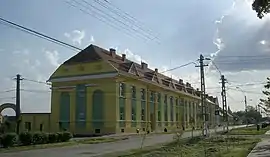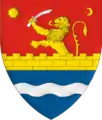Comloșu Mare
Comloșu Mare is a commune in Timiș County, Romania. It is composed of three villages: Comloșu Mare, Comloșu Mic and Lunga. Its sister-settlement is Magyarcsanád, Hungary.
Comloșu Mare | |
|---|---|
 Main road | |
 Coat of arms | |
 Location in Timiș County | |
 Comloșu Mare Location in Romania | |
| Coordinates: 45°53′N 20°38′E | |
| Country | |
| County | Timiș |
| Government | |
| • Mayor | Ovidiu Ştefănescu (PSD) |
| Population (2011)[1] | 4,737 |
| Time zone | EET/EEST (UTC+2/+3) |
| Vehicle reg. | TM |
Name
In German, it is known as Komlosch, in Hungarian as Nagykomlós, and in Serbian as Велики Комлуш / Veliki Komluš. In Hungarian, Comloșu Mic is called Kiskomlós, while Lunga is known as Kunszőllős.
Relevant Dates
- 1446 – First historical documents mention the commune;
- 1734 – A mass migration from the Olt Region;
- 1781 – Maria Theresia brings and settles a number of German families from Luxembourg;
- 1770 – Satellite village "Ostern" is created (Comloșu Mic);
- 1838 – Prominent poet, Iulian Grozescu, is born in the commune.
- 1890 – The commune is incorporated into the 'Torontal' township (district of Jimbolia) and the population reaches 5,235 residents;
- 1956 – The commune belongs to the Timișoara municipality (a sub-district of Jimbolia), and the population has declined to 4,030 residents.
History of commune planning
While a possession of the Habsburg empire, a plan of development was enacted in 1763. The plan was based on square blocks, and streets 40 meters wide. In the center of the village a park and a church ground was established. In addition, proper space was affected for the Parochial House, the school and the bodega. Like most other villages, a space was also dedicated to a weekly market place.
The house code prescribed that the dwelling was in the front while the barn was in the rear. This would prevent the fire (most likely in the barn) from spreading to the street.
For building material, compacted dirt was used with a roof of various wooden materials.
The planning of the streets took in the consideration the ethnic composition of their inhabitants. The planning went at great lengths to group together people of the same nationality and religion. The four main groups were: Romanians, Germans, Hungarians, and Serbs, but a small number of Slovaks were also settled. Some land was available for sale to anyone, and in those places the ethnic groups were allowed to mix.[2]
Lunga village is the site of a border crossing with Serbia. Inaugurated in 2014, it leads to the village of Nakovo.[3]
References
- "Populaţia stabilă pe judeţe, municipii, oraşe şi localităti componenete la RPL_2011" (in Romanian). National Institute of Statistics. Retrieved 4 February 2014.
- "City Hall of Comlosu Mare History Webpage".
- (in Romanian) "Punctul de trecere a frontierei Lunga (Timiș)-Nakovo (Serbia), deschis în prezenţa lui Victor Ponta", Adevărul, November 8, 2014
| Wikimedia Commons has media related to Comloșu Mare, Timiș. |

